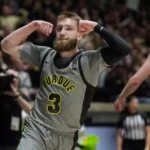Less than three weeks after its most humbling performance of the season, Michigan gets another crack at Purdue tonight (7:00 p.m., Peacock , get a special Peacock promo for $29.99 annually here ) at the Crisler Center.
Purdue is playing as well as any team in the country. The Boilermakers are 10-1 since January 1st and are the second-best team in the country during that span, per Bart Torvik, 6th on offense and 10th on defense. Before New Year’s, Purdue wasn’t on the same level. During November and December, Purdue rated 30th overall, 13th on offense, and 85th on defense.
Almost with a flip of a switch, Matt Painter fixed his defense over the holidays. He benched Myles Colvin and Camden Heide for CJ Cox and Caleb Furst. He altered his scheme to be more aggressive and hunt turnovers. And everything fell into place for another run at the Big Ten title.
The Boilermakers are gunning for a third straight Big Ten title and sit a half-game ahead of Michigan and Michigan State at the top of the standings while playing the best basketball in the conference.
(function() {
window.mc4wp = window.mc4wp || {
listeners: [],
forms: {
on: function(evt, cb) {
window.mc4wp.listeners.push(
{
event : evt,
callback: cb
}
);
}
}
}
})();
This story is free for non-members. Get more free content:
The Boilermakers
Matt Painter’s teams have been on a magical four-year run offensively, on pace for a fourth-straight top-15 finish in adjusted offensive efficiency. The most impressive part of Purdue’s offensive dominance is that Painter has reinvented his system around very different players — Jaden Ivey, Zach Edey, Braden Smith, Trey Kaufman-Renn, etc. — and still found success.
This year’s system is simple: let Braden Smith operate out of ball screens. Purdue ranks in the 85th percentile in pick and roll volume (including passes) and the 85th percentile in scoring efficiency. The Boilers are 4th in the Big Ten in ball screen volume, which is impressive because they were last in the league consistently as recently as four years ago.
Purdue leads the Big Ten in effective field goal percentage at 57%, shooting 59.2% on twos (1st) and 35.4% on threes (4th). The rest of the offense is solidly above average in the Big Ten: 4th in turnover rate, 6th in offensive rebounding, and 6th in free-throw rate. Purdue isn’t a high-volume 3-point shooting team at 36.3% of attempts, but the guards and wings who are on the floor are all going to let it fly — four low-usage rotation players take more threes than twos.
Purdue’s defensive resurgence is legitimate and a primary reason it is hunting for a Big Ten title. Early in the year, it felt like this would be a 2021-22 Purdue or 2013-14 Michigan team that was special offensively but limited defensively. That’s no longer the case.
The Boilermakers haven’t just been effective defensively, allowing 1 point per possession in league games (2nd Big Ten); they have a distinct style of play.
The hallmark of the defensive shift is forcing turnovers. Purdue forces giveaways on 22% of possessions in Big Ten games, the best in the league, and has ranked 11th nationally in forced turnover rate since January 1st. This team isn’t afraid to double the post, load up in the paint, help early, and then allow Braden Smith to play free safety and chase steals on the weak side.
Purdue likes to ice ball screens and force ball handlers to their weak hand, and Michigan’s guards and wings struggled to get into any sort of offensive flow in the first meeting.
The defensive scheme also excels at limiting shot attempts in the paint. Purdue doesn’t have much rim protection but it does a good job of rim prevention. Purdue is still ranked 332nd in 2-point defense since the Jan. 1 shift and even allows 64.4% shooting at the rim. The catch? Teams only attempt 39.9% of their shots at the rim. Purdue is the second-worst shot-blocking team in the Big Ten but puts enough pressure on the ball and bodies in the paint to force other shot attempts.
Packing the paint and preventing shots at the rim allows opponents to shoot more threes. Purdue checks in at 332nd nationally in 3-point volume allowed since Jan. 1 but has allowed just 28% 3-point shooting during that span.
Personnel
6-foot junior guard Braden Smith is the best point guard in America. There might be better draft prospects or higher-upside players, but no guard is a better college basketball player right now.
There’s no weakness in Smith’s offensive game. He’s an elite playmaker and passer out of ball screens, and he scores efficiently in every spot on the floor: 60% at the rim, 50% on runners, 47% on pull-up twos, 35% on pull-up threes, 40% on catch-and-shoot threes.
Smith had 24 points on 17 shots, 10 assists, seven rebounds, and four steals against Michigan, and it feels like that line even sells him short. This reel of “points created” by Smith from that game lasts five minutes; it might as well just be a game highlight. He was the entire show.
[youtube https://www.youtube.com/watch?v=Zl1FJgXoBv8?feature=oembed&w=1000&h=563]
6-foot-9, 230-pound big man Trey Kaufman-Renn is Smith’s favorite target, and he’s an elite scorer in the paint.
Kaufman-Renn rarely takes a shot outside the paint, but it is almost impossible to prevent him from attempting shots in the paint. He shoots 61% on twos and has marvelous chemistry with Smith as a short roller. If he can catch the ball anywhere around the free-throw line, he will figure out how to get off a quality look.
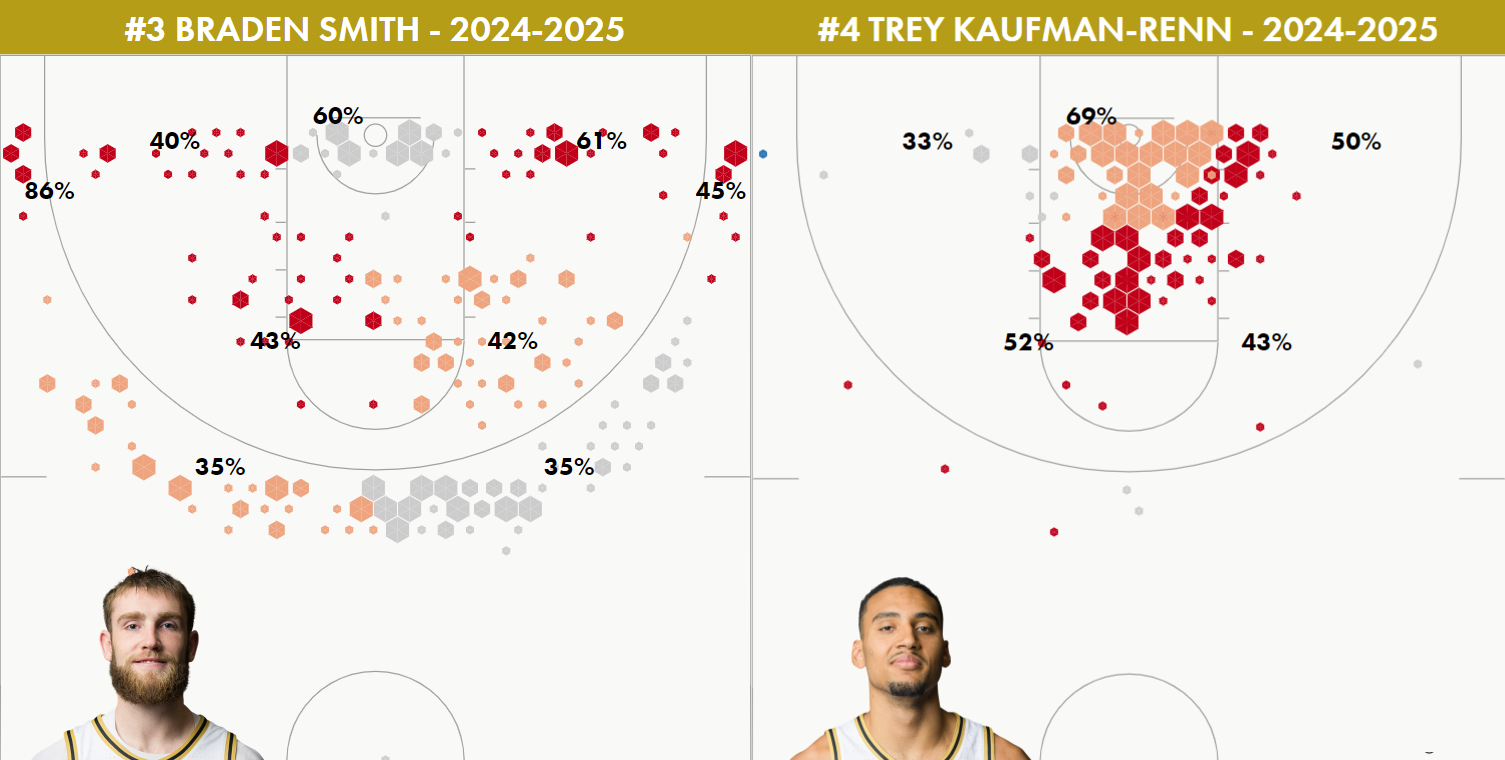
He can score with his back to the basket, but the push shot makes him unique. He’s 28-of-50 from the floor on runners, per Synergy, which puts him in the top 10 nationally for made runners. This is a shot that you think of guards and wings taking, but he has the uncanny ability to flip it into the hoop from 8 to 12 feet out.
6-foot-5 junior Fletcher Loyer is the primary floor spacer on the roster, knocking down 49-of-107 threes (46%). He’s the guy you can never help off of defensively because he’ll make you pay, but he’s a more dynamic scorer than his reputation. He’s effective in coming off screens, dribble handoffs, and even the occasional ball screen and getting to an in-between game.
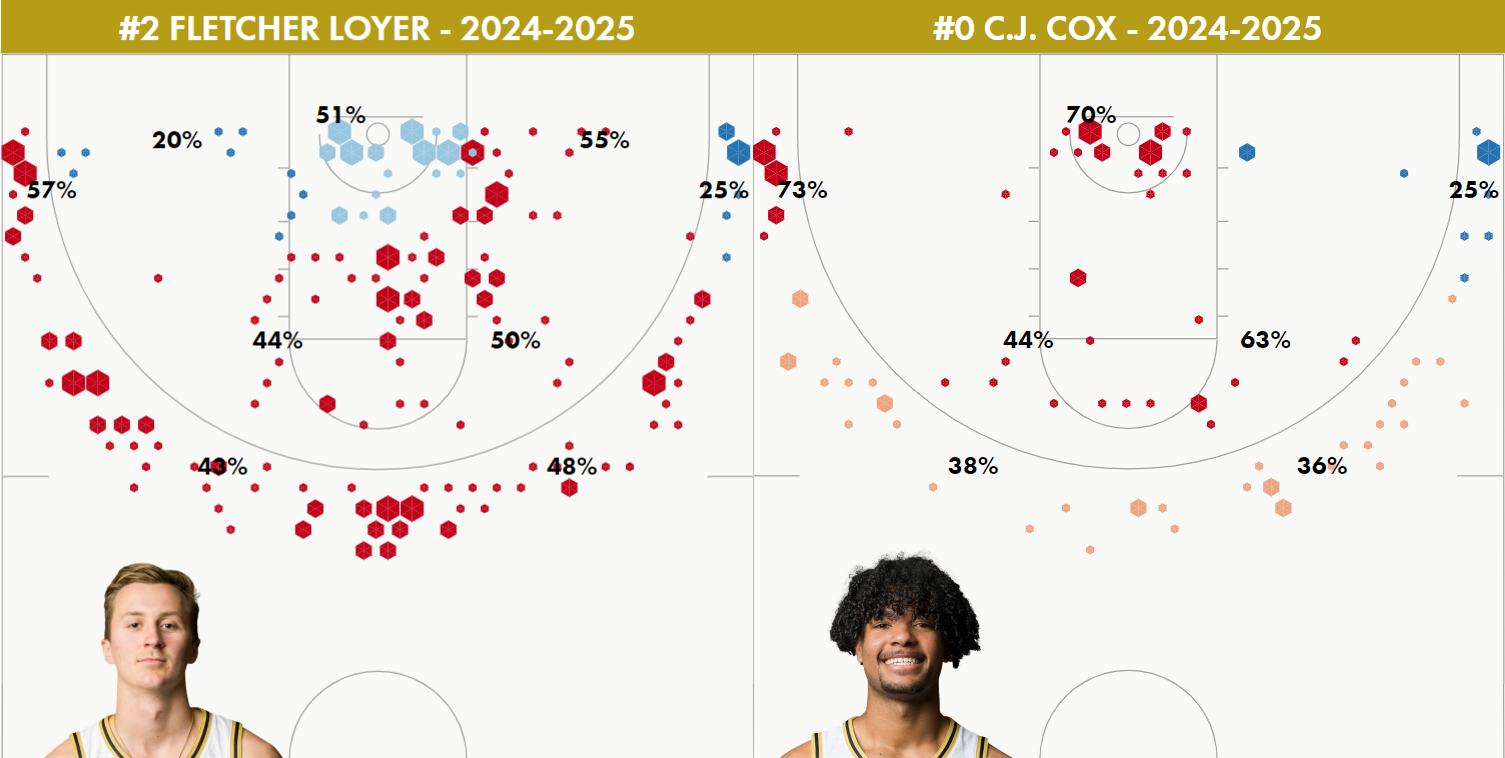
6-foot-3 freshman CJ Cox and 6-foot-10 senior Caleb Furst were the defensive reinforcements that changed the Boilermaker defense. Cox’s role revolves around pressuring the ball, and he set the tone early against Michigan by stripping Tre Donaldson. Furst is a big physical big who disrupted Michigan’s 4-5 ball screen game and can switch onto either U-M big man. Offensively, Cox shoots 42% from deep (58% of attempts) and Furst is primarily a catch-and-finish big around the bucket.
6-foot-5 guard Myles Colvin and 6-foot-7 wing Camden Heide were the original starters on the wing. The shift from hybrid-y wing forwards to an extra guard (Cox) and another big (Furst) is the crux of the lineup adjustment. The other factor is that Colvin and Heide struggle on both sides of the court. Colvin shoots 29% from three (69% of attempts) and Heide is at 31% (67% of att.). Unsurprisingly, Purdue’s defensive numbers fall off a cliff when Heide is on the floor.
6-foot-3 freshman guard Gicarri Harris logs 15 to 20 minutes per game, shooting 61% from two and 27% from three (63% of attempts).
6-foot-11 freshman Raleigh Burgess went 2-of-2 from deep vs. U-M at Mackey and is 4-of-13 in his other minutes. He’s not a big contributor, but he is coming off of an 8-point game against USC and should factor into the rotation, given Michigan’s size.
Keys, Matchups & Adjustments
Defending the Smith/Kaufman-Renn Ball Screen
Braden Smith is the best guard in the country, and Kaufman-Renn is among the best paint finishers. The duo has elite chemistry and is the best assist combo in the country by a whopping 14 dimes. Not only do you have to worry about that two-man game, but Smith-to-Loyer is the fourth-most prolific assist duo, too.
Smith is hard to stop and knows how to find his favorite targets.
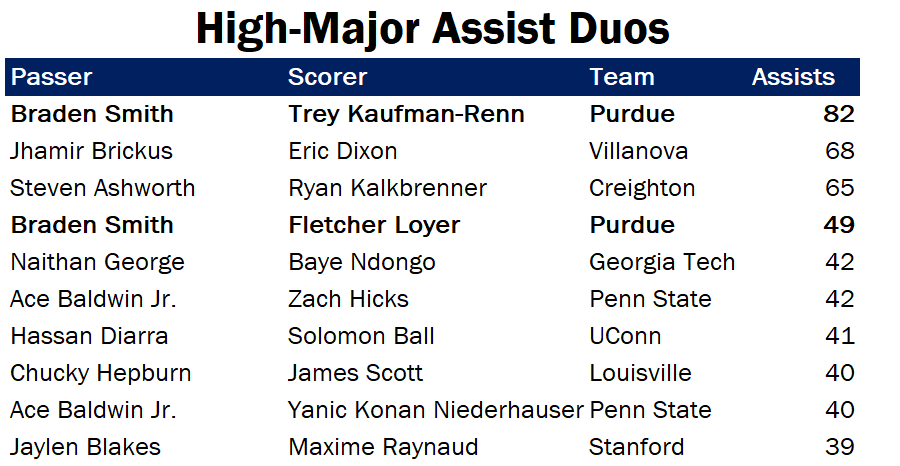
Dusty May used Goldin to defend Kaufman-Renn, meaning Michigan primarily stuck to its standard drop defense against the ball screen action.
That wasn’t a shock, given how Michigan plays most nights, but it is hard to imagine that May and his staff won’t have some wrinkles to introduce. I don’t think you can do the same thing every trip down the court against Smith because he’s too dangerous if he knows what’s coming.
So, how can the Wolverines adjust? The first meeting was out of hand too quickly for any radical experiments, and May wasn’t keen to share any strategic moves during his Monday availability. However, you can bet he’ll have a few new things to try.
The Wolverines can mix up their base coverage on a few possessions, but they also can manipulate things with defensive matchups. Danny Wolf could guard Kaufman-Renn, enabling Michigan to switch the Smith/Kaufman-Renn screen while Goldin stays in the paint with Furst.
Turnovers & Transition Defense
Michigan is the most turnover-prone team in the Big Ten, and Purdue forces the most turnovers in the Big Ten. In the first meeting, Michigan turned it over on 31% of its possessions, and Purdue had 14 steals. The Boilermakers scored 29 points off of turnovers and 19 fast break points. Every single stat that I just listed is a season-worst performance for Michigan.
These giveaways, pick-sixes, and transition baskets made the game irrelevant by the first media timeout. Michigan’s turnover issues—and subsequent defensive transition issues—were so bad that the team had no chance to compete.
A better turnover performance and forcing Purdue into a half-court game won’t win Michigan the rematch, but it is a non-negotiable to at least be competitive.
3-Point Shooting
There are Big Ten teams that force you to beat you with anything other than threes (hi, Illinois!), and then there are teams that force you to make perimeter shots to win (hi, Nebraska!). Purdue isn’t quite Nebraska, but it is in the same family.
Big Ten opponents attempt 45% of their shots from deep against Purdue and have attempted at least 40% of their shots from three against Purdue in nine of the last ten games. Purdue is 14-0 when opponents shoot worse than 32% from three and 5-5 when they top that mark.
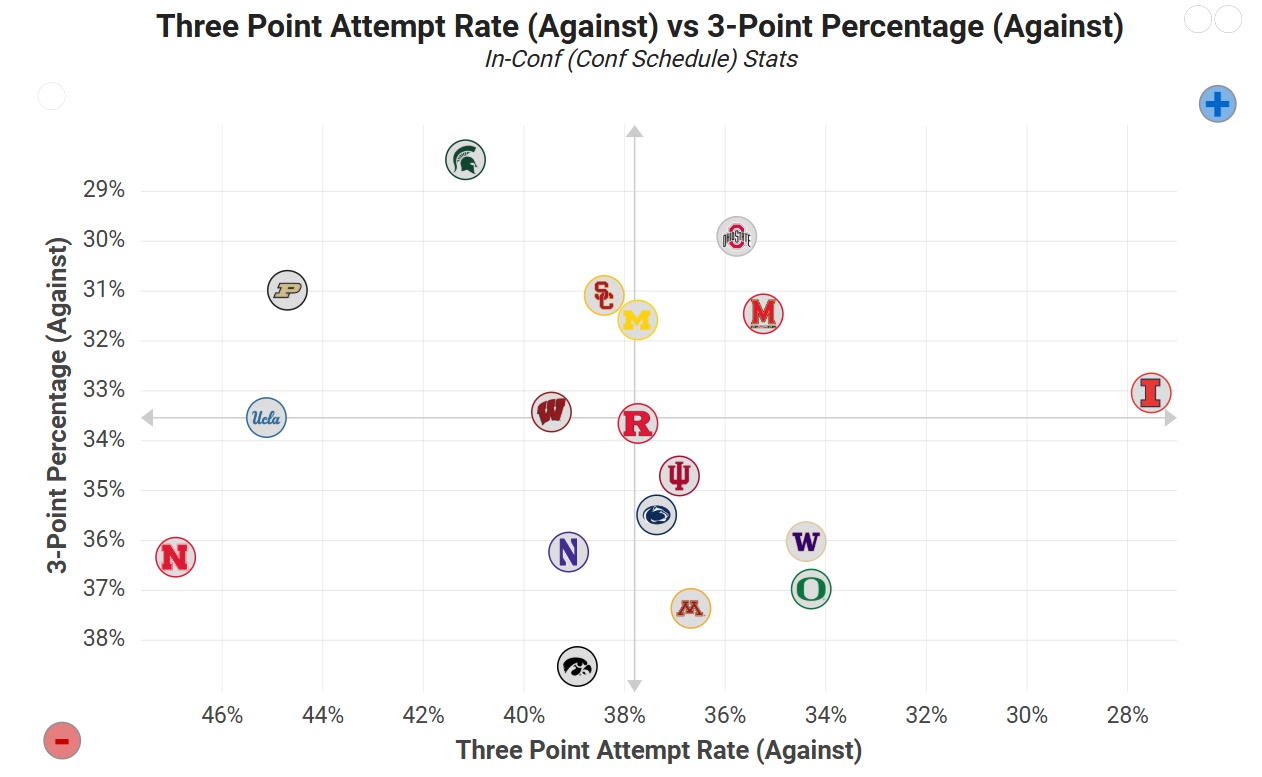
Michigan shoots 36% from deep as a team and 34% in Big Ten play, but it has been in a slump. The Wolverines have shot 30% from deep over the last six games and didn’t make a triple in the final 28 minutes of Saturday’s win at IU.
Some of those shots must fall at home to change the script. This is Michigan’s third game in seven days, so tired legs are also a potential worry.
The two-man game
It felt like the first game was over before Michigan successfully executed a four-five pick-and-roll. Purdue’s defensive approach was to switch the pick and rolls with a heavy dose of physical play.
This early pick-and-roll play is an excellent example of the approach. Purdue switches it, Caleb Furst delivers a blow to Vlad Goldin, and Goldin never gets to his spot. Smith and Loyer are loaded up in the paint on the back side to provide help.
It will be a long night if Wolf and Goldin get pushed off their spots like this in the rematch. Purdue played with a degree of physicality that Michigan didn’t match at Mackey. Michigan players and coaches have preached physicality ever since, but this will be a real test.
Bottom Line
For Michigan, this is the ultimate shot at revenge. For Purdue, this is the first of three games that could win them a Big Ten title — at Michigan, Wisconsin, at Michigan State. If Purdue wins those three, it can deliver a knockout blow to the title race before the end of the month. On the other hand, each opponent will be playing to keep their title dreams alive.
If the Wolverines don’t win this one, the road to a Big Ten title is uphill at best. Bart Torvik’s simulations give Michigan a 53% chance at a share of the Big Ten title (28% outright) with a win tonight and just 17% (5% outright) with a loss.
KenPom projects a 76-75 Michigan win, with a 52% chance for the home Wolverines.
The post Game 24: Purdue at Michigan Preview appeared first on UM Hoops.com .

